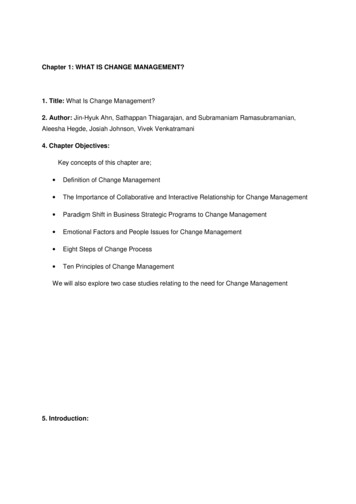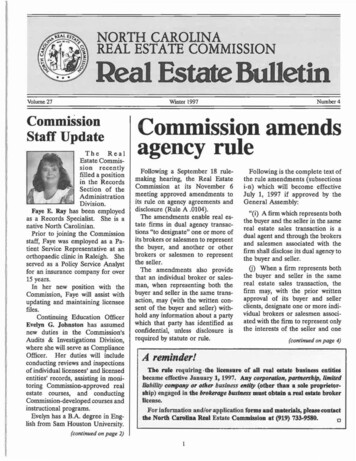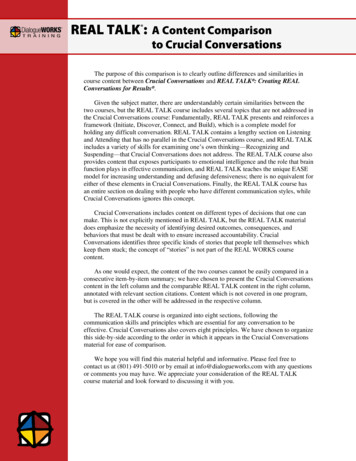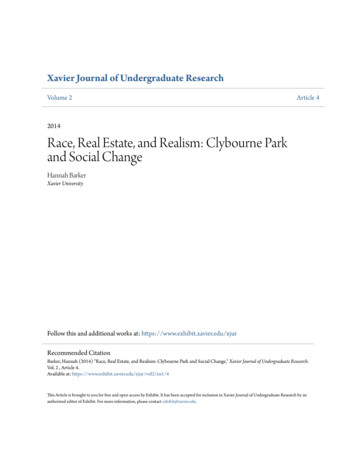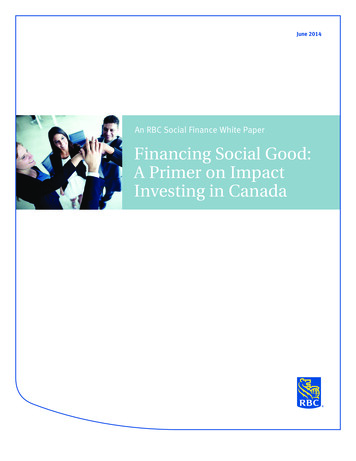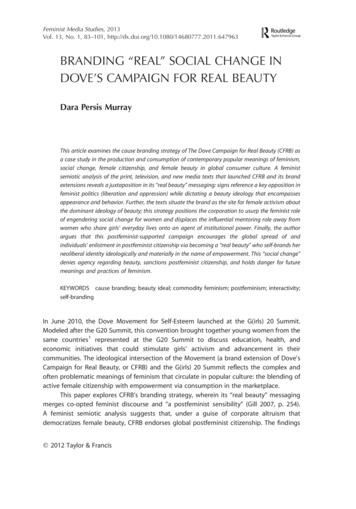
Transcription
Feminist Media Studies, 2013Vol. 13, No. 1, 83–101, DING “REAL” SOCIAL CHANGE INDOVE’S CAMPAIGN FOR REAL BEAUTYDara Persis MurrayThis article examines the cause branding strategy of The Dove Campaign for Real Beauty (CFRB) asa case study in the production and consumption of contemporary popular meanings of feminism,social change, female citizenship, and female beauty in global consumer culture. A feministsemiotic analysis of the print, television, and new media texts that launched CFRB and its brandextensions reveals a juxtaposition in its “real beauty” messaging: signs reference a key opposition infeminist politics (liberation and oppression) while dictating a beauty ideology that encompassesappearance and behavior. Further, the texts situate the brand as the site for female activism aboutthe dominant ideology of beauty; this strategy positions the corporation to usurp the feminist roleof engendering social change for women and displaces the influential mentoring role away fromwomen who share girls’ everyday lives onto an agent of institutional power. Finally, the authorargues that this postfeminist-supported campaign encourages the global spread of andindividuals’ enlistment in postfeminist citizenship via becoming a “real beauty” who self-brands herneoliberal identity ideologically and materially in the name of empowerment. This “social change”denies agency regarding beauty, sanctions postfeminist citizenship, and holds danger for futuremeanings and practices of feminism.KEYWORDS cause branding; beauty ideal; commodity feminism; postfeminism; interactivity;self-brandingIn June 2010, the Dove Movement for Self-Esteem launched at the G(irls) 20 Summit.Modeled after the G20 Summit, this convention brought together young women from thesame countries1 represented at the G20 Summit to discuss education, health, andeconomic initiatives that could stimulate girls’ activism and advancement in theircommunities. The ideological intersection of the Movement (a brand extension of Dove’sCampaign for Real Beauty, or CFRB) and the G(irls) 20 Summit reflects the complex andoften problematic meanings of feminism that circulate in popular culture: the blending ofactive female citizenship with empowerment via consumption in the marketplace.This paper explores CFRB’s branding strategy, wherein its “real beauty” messagingmerges co-opted feminist discourse and “a postfeminist sensibility” (Gill 2007, p. 254).A feminist semiotic analysis suggests that, under a guise of corporate altruism thatdemocratizes female beauty, CFRB endorses global postfeminist citizenship. The findingsq 2012 Taylor & Francis
84DARA PERSIS MURRAYsuggest that CFRB may reflect a social change in the relationship between corporations andaudiences that carries perilous meanings for the future roles of feminists and practices offemale citizenship in global consumer culture. CFRB offers a rich site for unpacking theproduction and consumption of popular meanings of feminism, social change, femalecitizenship, and female beauty at this cultural moment.Dove Gets the Word OutDove is a brand of personal care products such as soaps, body washes, and body lotionsmanufactured by the Unilever Corporation. Since 1957, Dove’s mainstay product has been theBeauty Bar. In 2002, Unilever reassessed Dove’s marketing strategy with its public relations firm,Edelman, and its advertising/marketing agency, Ogilvy & Mather, to create a unified globalimage to generate brand loyalty. Discussing her view of the global brand, Ogilvy’s Chairmanand Chief Executive Officer Shelly Lazarus stated, “It means figuring out what is universal aboutthe brand–those things that transcend where it happens to be manufactured, or where itstarted” (O’Barr, Lazarus & Moreira 2008). Lazarus’s statement indicates that in today’s market, abrand needs to reach audiences’ emotions by building a platform that drives ideologicalalliance with the corporate identity before the act of material consumption.CFRB was largely shaped by women in industry and as research subjects. Femalemembers of Ogilvy & Mather’s CFRB team included Lazarus, two creative directors, an artdirector, a writer, and producer. Lazarus is a graduate of Smith College (an all-women’sinstitution listing numerous feminist icons among its alumni), where she sat on its Boardof Trustees. Although Lazarus has not publicly aligned herself with feminism, othershave identified her as “a strong feminist . . . Yet Lazarus’s feminist love of economicempowerment prevents her from acknowledging the ways in which capitalism can hurt thepowerless” (Dyer 2004, p. 191). Moreover, Dove commissioned women2 to direct itsfoundational research and conduct much of the Campaign’s research.The construction of CFRB was based on Dove’s 2003 global research study, “The RealTruth About Beauty.” This research involved the participation of thirty-two hundredwomen, ages eighteen through sixty-four, in ten countries, in a twenty to twenty-fiveminute long telephone interview. The study found that less than 2 percent of women feelbeautiful; 75 percent want representations of women to reflect diversity through age,shape, and size; and 76 percent want the media to portray beauty as more than physical(Etcoff, Orbach, Scott & D’Agostino 2004). These responses suggested a market for a newphilosophy of beauty that was “a great opportunity to differentiate the brand from every[other] beauty brand” (Fielding, Lewis, White, Manfredi & Scott 2008), according toAlessandro Manfredi, Dove’s Global Brand Director. CFRB has been identified as a causemarketing effort (Lachover & Brandes 2009), which associates corporate identities withsocial problems to benefit the corporate image, “distracting attention from their [thecorporation’s] connections as to why these social problems continue to exist” (Stole 2008,p. 21). This article advances that CFRB is a cause branding strategy that merges messages ofcorporate “concern and commitment for a cause” (Cone 2000) with the participation ofwomen and girls for the same social goals, further concealing corporate aims.In line with their findings, Dove announced its challenge to the dominant ideology ofbeauty: it would feature “real” women and girls of “various ages, shapes and sizes”(Campaign for Real Beauty 2008). The campaign launched in England in 2004, and was soonexported to Canada and the United States; CFRB is currently marketed in thirty-five
BRANDING “REAL” SOCIAL CHANGE85countries.3 The branding strategy was executed through television and print advertising,billboards, new media, and national and grassroots outreach. The Dove Self-Esteem Fund isa brand extension that serves as the site for in-person and online workshops that provide“self-esteem toolkits” for girls and “parent kits” for mothers/mentors. In the United States,the Fund has partnered with multiple national nonprofit girls’ organizations (Girl Scouts,Girls Inc., and Boys & Girls Clubs of America) to facilitate these workshops. As an example ofCFRB’s international events that engage female audiences, Dove “call[ed] on women fromthe Middle East to write about someone they find beautiful and the reasons they see adifferent kind of ‘real beauty.’ Participants could be treated to a luxury five-star treatmentfor two” (Dove Exposes the Beauty Myth 2007) in return. The Dove Movement for SelfEsteem launched in Canada and the United States in Fall 2010.In the worldwide exportation of CFRB texts,4 Dove positioned their global brandthrough unified messaging that translates its main idea in images and language suiting thecustoms of each target geographic area. This analysis interrogates the branding textslaunched in the United States: six print texts that communicate the “real beauty” ideology, atelevision commercial and a viral video (“True Colors” and “Evolution,” respectively) thatpromote the Fund, and a website that advances the Movement.Meaning Making about “Real Beauty”: Revealing Textual Meaningsthrough SemioticsSemiotics is a useful approach for teasing out denotative and connotative meanings inmedia texts. Interrogating signs’ oppositional relations is central to examinations of ideologicalmeaning and power (Williamson 1978), as illuminating differences in meaning leads to anunderstanding about the unfamiliar by comparing it with the familiar. The semiotic analysispresented here decodes the ways in which CFRB’s signs about “real beauty” communicatemeanings of liberation and oppression. It unpacks CFRB’s print texts via their language, logos,and positioning of bodies, thereby linking connotative chains of meaning that exploit similarityand difference (Danesi 2002). To analyze CFRB’s television advertisement and viral video, thelatter of which bears similarity to the codes and conventions of television, media scholar JohnFiske’s (2000) work is helpful. These analytical categories include camera work, lighting, editing,music, casting, setting, costume, make-up, and action.Signs develop through social convention and audiences interpret them throughlearned social codes that cohere to maintain hegemony (Seiter 1992). For semiotician RolandBarthes, signs contribute to the creation of social myths, which convey social and politicalmeanings (Bignell 1997, p. 22). The myth’s veracity is shaped by its “distortion or forgetting ofalternative messages, so that the myth appears to be exclusively true, rather than one of anumber of different possible messages” (1997, p. 22). At this level of signification, manyconnotations attach to a sign to comprise a social myth, such as “real beauty.” Myth in CFRB isexamined as a means of branding the corporation as a feminist advocate for women (althoughthis strategy oppresses women) as well as a process of self-branding women and girls asempowered “real beauties” (although they circulate in culture as signs of corporate identity).A Feminist Perspective on BeautyIn the twentieth and twenty-first centuries, the beauty and fashion industries haveproduced powerful media images communicating the dominant ideology of female beauty
86DARA PERSIS MURRAYas ultra-thin, tall, sexual bodies. Consumption of these images has resulted in a culturalnorm of women and girls disciplining their bodies (Bordo 2003). The beauty industry’sdiscourse connects ideological and physical nonconformity to the dominant ideology witha woman’s inability to fulfill her gender role or experience happiness (Bartky 1990). Thestruggle of women and girls to physically emulate media images has manifested itself ineating disorders and body image issues, while the lack of a fulfilled identification may resultin low self-esteem (Kilbourne 1999).Dove’s stated call to arms echoes feminist and feminist media studies scholarship thataddresses how representations in popular culture convey often-problematic meanings ofgender and beauty. In its advocacy of women’s rights and egalitarian roles, the feministposition argues for social change of oppressive social structures (Dworkin 1974). Bycontrast, the postfeminist position contends that gender equality and femaleempowerment have been achieved in the public sphere. Postfeminism has immensepower in western culture, as noted by feminist media studies scholar Rosalind Gill, whonames our current time a “postfeminist media culture” (2007, p. 249). Significantly, sheadvances that postfeminism can be interpreted as “a sensibility” (2007, p. 254) whosemessaging includes:the notion that femininity is a bodily property; the shift from objectification tosubjectification; the emphasis upon self-surveillance, monitoring and discipline; a focusupon individualism, choice and empowerment; the dominance of a makeover paradigm;the articulation or entanglement of feminist and antifeminist ideas . . . and an emphasisupon consumerism and the commodification of difference. (Rosalind Gill 2007)The postfeminist position easily aligns with corporate interests, situating messages ofwomen’s freedom in the marketplace as “empowered consumer[s]” (Tasker & Negra 2007,p. 2). This identity lies at the intersection of consumerism and neoliberal governmentality,thereby separating meanings of female citizenship from civic engagement (Mcrobbie 2008,p. 533). The emergent neoliberal postfeminist citizen links meanings of empowerment andchoice to ideological and material consumption.The postfeminist citizen’s pursuit of beauty engages her consumer power and selfgovernance, aligning her identity with the goals of institutional power. In postfeministmedia culture, the body is a site of attention for the postfeminist citizen since it is promotedas integral to female identity (Gill 2007, p. 255). Consumption of the dominant ideology ofbeauty involves absorbing representations and meanings of hypersexual women and,increasingly, girls. Agreement with these messages may make it difficult for postfeministcitizens to understand their sexuality in “healthy, and progressive ways” (Durham 2008,p. 39). This feminist analysis will consider the political, social, and economic meanings inCFRB’s texts and address how female identity may be shaped as postfeminist citizenshipthrough the myth of “real beauty.”Self-Branding by Embracing Popular FeminismA strategy for accomplishing audience identification with texts is the co-option ofdiscourse; importantly, such appropriation highlights social issues as a means of generatingsales (Danesi 2002). Alignment with co-opted subcultural signs allows consumers to thinkof themselves as insurgents; yet, since their rebellion occurs through consumerism, they donot “pay the social price of true non-conformity and dissent” (Danesi 2002, p. 197).
BRANDING “REAL” SOCIAL CHANGE87Sociologist Robert Goldman terms this tactic “commodity feminism,” wherein advertisersattempt “to reincorporate the cultural power of feminism” (Goldman 1992, p. 130) and, in sodoing, depoliticize the feminist message.Commodity feminism takes on new meaning in a consumer
The ideological intersection of the Movement (a brand extension of Dove’s Campaign for Real Beauty, or CFRB) and the G(irls) 20 Summit reflects the complex and often problematic meanings of feminism that circulate in popular culture: the blending of active female citizenship with empowerment via consumption in the marketplace. This paper explores CFRB’s branding strategy, wherein its .

